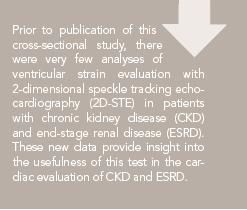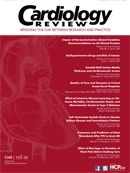Left Ventricular Systolic Strain in Chronic Kidney Disease and Hemodialysis Patients


Srikanth Seethala, MD, MPH
REVIEW
Liu Y-W, Su C-T, Yang C-S, et al. Left ventricular systolic strain in chronic kidney disease and hemodialysis patients. Am J Nephrol. 2011;33:84-90.
T
his cross-sectional study provides an insight into the usefulness of 2-dimensional speckle tracking echocardiography (2D-STE) in the cardiac evaluation of chronic kidney disease (CKD) and end-stage renal disease (ESRD).
Study Details
The authors compared 37 CKD and 60 ESRD patients with 56 randomly selected controls who did not have any kidney problems and who were having an echocardiogram for other medical reasons. ESRD patients had an echocardiogram halfway through the hemodialysis session (the 2nd or 3rd hour of each session). Authors measured the end expiratory inferior vena cava (IVC) diameter to assess the volume status in ESRD patients. In order to compare volume status between CKD and ESRD patients, the authors also measured the left ventricular diastolic volume index (LV EDVi), the left atrial volume index (LAVI), and the stroke volume (SV) in all three groups of patients.
The 2D-STE analysis was performed by cardiologists without knowledge of the clinical information. The average of the three apical peak longitudinal strain values is considered the global peak systolic longitudinal strain (GS1). Circumferential strain (Sc) and strain rates (SRc) were the average of the six mid-papillary left ventricular (LV) segmental strain values measured during the parasternal views.
Even though CKD, ESRD, and controls had similar left ventricular ejection fractions (LVEF), the average LV mass index and diastolic dysfunction were higher in the CKD and ESRD groups. LV mass index was higher in the ESRD group compared with the CKD group. CKD and ESRD patients had more global ventricular strain compared with controls in order to maintain similar ejection fraction (EF). CKD patients had more negative GS1 values when compared with the ESRD group, indicating that CKD patients have more diastolic dysfunction compared with the ESRD group. Volume status of the patients will not explain this difference, as both groups had similar LV EDVi, LAVI, and SV. There was no significant difference in the GS1 values between dialysis or interdialytic days. However, the size of the study population for this finding was very limited.
The major limitation of the study is its cross-sectional design. It identified the differences between the three groups of patients but did not explain the progression of LV dysfunction from normal renal function to CKD and to ED. It is also limited by sample size, particularly with respect to the CKD group.
References
1. Hayashi SY, Brodin LA, Alvestrand A, et al. Improvement of cardiac function after haemodialysis. Quantitative evaluation by colour tissue velocity imaging. Nephrol Dial Transplant. 2004;19:1497-1506.
2. Yan P, Li H, Hao C, et al. 2D-speckle tracking echocardiography contributes to early identification of impaired left ventricular myocardial function in patients with chronic kidney disease. Nephron Clin Pract. 2011;118:c232-240.
3. Gulel O, Soylu K, Yuksel S, et al. Evidence of left ventricular systolic and diastolic dysfunction by color tissue Doppler imaging despite normal ejection fraction in patients on chronic hemodialysis program. Echocardiography. 2008;25:569-574.
4. Edwards NC, Hirth A, Ferro CJ, Townend JN, Steeds RP. Subclinical abnormalities of left ventricular myocardial deformation in early-stage chronic kidney disease: the precursor of uremic cardiomyopathy? J Am Soc Echocardiogr. 2008;21:1293-1298.
5. Aljaroudi W, Koneru J, Iqbal F, Aggarwal H, Heo J, Iskandrian AE. Left ventricular mechanical dyssynchrony by phase analysis of gated single photon emission computed tomography in end-stage renal disease. Am J Cardiol. 2010;106:1042-1047.
6. Rudhani ID, Bajraktari G, et al. Left and right ventricular diastolic function in hemodialysis patients. Saudi J Kidney Dis Transpl. 2010;21:1053-1057.
7. Dandel M, Lehmkuhl H, Knosalla C, Suramelashvili N, Hetzer R. Strain and strain rate imaging by echocardiography - basic concepts and clinical applicability. Curr Cardiol Rev. 2009;5:133-148.
8. Liu YW, Su CT, Huang YY, et al. Left ventricular systolic strain in chronic kidney disease and hemodialysis patients. Am J Nephrol. 2011;33:84-90.
9. Choi JO, Shin DH, Cho SW, et al. Effect of preload on left ventricular longitudinal strain by 2D speckle tracking. Echocardiography. 2008;25:873-879.
10. McAlister FA, Ezekowitz J, Tonelli M, Armstrong PW. Renal insufficiency and heart failure: prognostic and therapeutic implications from a prospective cohort study. Circulation. 2004;109:1004-1009.
COMMENTARY
Identifying High-Risk Patients
T
he prevalence of chronic kidney diseases and ESRD has gradually increased over the last several years. Cardiovascular diseases account for more than half of the deaths in CKD and ESRD patients. The pathophysiological mechanisms contributing to these deaths are not clearly understood.1 Conventional echocardiogram is a reliable method for estimating EF and LV mass index. EF provides an estimation of the global myocyte contractions but will not provide a significant insight into the regional systolic function.2 Moreover, studies have shown that there have been significant changes in cardiac function that will occur much earlier than the EF change.2-4 ESRD patients could have mechanical dyssynchrony even without electrical dyssynchrony and normal EF.5 ESRD patients could have both right and left ventricular dysfunction and still have normal EF.6 With advances in tissue Doppler imaging (TDI), it is possible to identify diastolic and systolic dysfunctions.
There are significant numbers of studies that have shown the usefulness of TDI in identifying diastolic dysfunction in CKD and ESRD patients.1,3,6 With TDI one can not only diagnose diastolic dysfunction but also can estimate the longitudinal strain early in the disease course.3 Unfortunately, TDI is an angle-dependent study and the angle of the study should be below 20 degrees. Moreover, it is a time-intensive study that has a high inter- observer variation and requires expert interpretation. 2D-STE is a novel method of calculating the ventricular strain pattern that provides a reliable estimation of ventricular strain analysis in a shorter duration of time than TDI. It provides an angle-independent assessment and has less inter-observer variability.2,7 The accuracy of 2DSTE is well established in estimating ventricular strain.2,7
There are very few studies of ventricular strain evaluation with 2D-STE in CKD and ESRD patients.2,8,9 The study by Liu et al is the first published study that provides insight into the role of 2D-STE in the evaluation of the CKD and ESRD patients, and confirms that ESRD and CKD patients have more diastolic dysfunction than controls that were well assessed previously with TDI. CKD and ESRD patients have more ventricular strain (more negative value) than controls. Yan et al conducted a similar study, and were able to reproduce similar results.2 They identified an inverse relation not only between Nterminal pro-B-type natriuretic peptide (BNP) and radial peak systolic strain but also between calcium phosphorus product and mid-wall peak systolic strain.2
The study by Liu et al is the first to use 2D-STE to evaluate strain difference between dialysis day and interdialytic day—and they were unable to show any significant difference between those days. In their study, Choi et al identified a statistically significant difference in the ventricular strain before and after dialysis. The differences in the results reported in these studies could be because in Liu et al’s study, the strain pattern was evaluated 2 to 3 hours after the initiation of dialysis during the dialysis day and during the interdialytic day. There was no significant difference in the volume status between the dialysis and interdialytic day. These studies provide insight into the ventricular strain pattern, but we need a much larger cohort of studies to identify the progression of the ventricular dysfunction over the course of CKD progression to ESRD. Heart failure patients with CKD have a high mortality rate.10 Identifying high-risk patients and optimizing their medical management early in the disease course will help to improve their longevity.
About the Author
Srikanth Seethala, MD, MPH, is an Assistant Professor in the Department of Internal Medicine at the Paul L Foster School of Medicine, Texas Tech University Health Sciences Center in El Paso, TX. Dr Seethala received his MD from Andhra Medical College in Visakhapatnam, India, and received his Master’s in Public Health from Northern Illinois University in DeKalb. His residency in internal medicine was at the University of Pittsburgh Medical Center-Mercy Hospital of Pittsburgh. He plans to pursue electrophysiology as a career.
